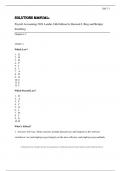Exam (elaborations)
SOLUTIONS MANUAL: Payroll Accounting 2024 Landin 34th Edition by Bernard J. Bieg and Bridget Stomberg
- Course
- Institution
- Book
SOLUTIONS MANUAL: Payroll Accounting 2024 Landin 34th Edition by Bernard J. Bieg and Bridget Stomberg
[Show more]



